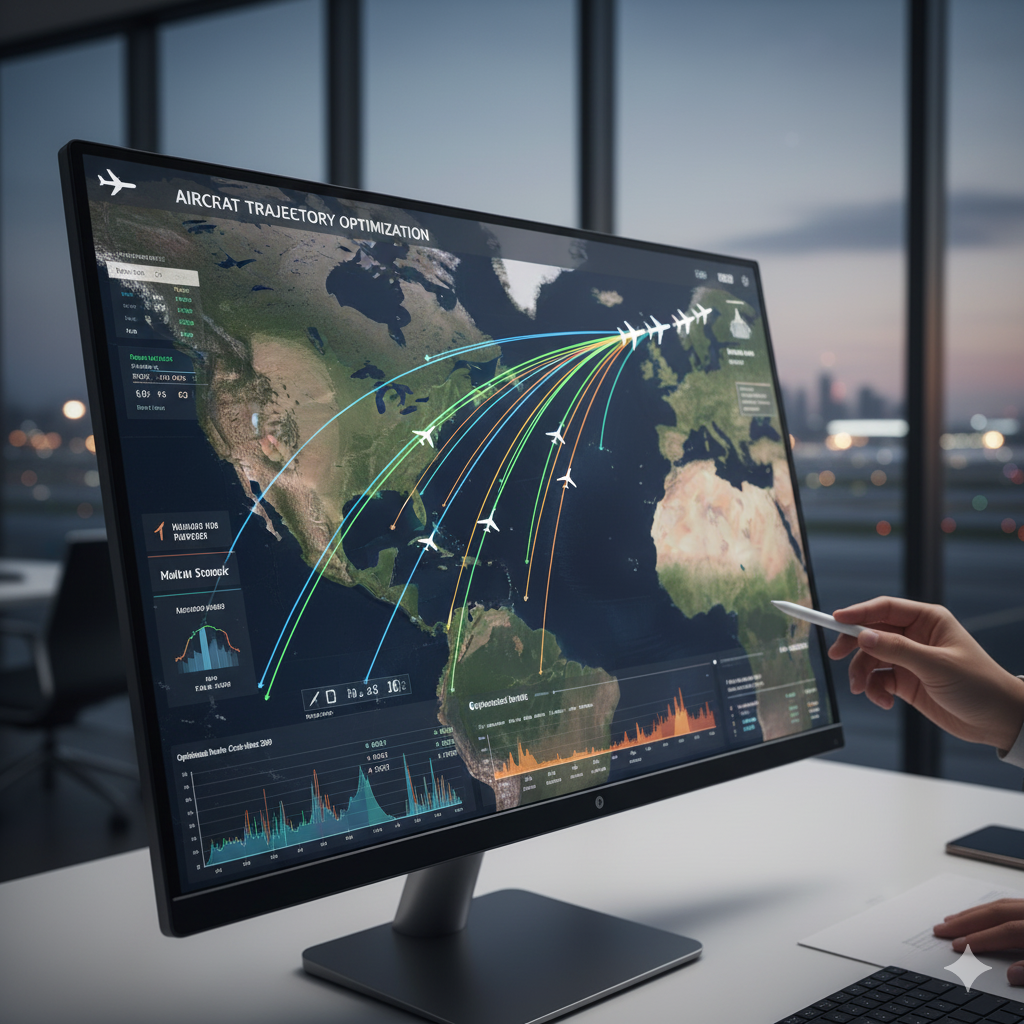Aircraft trajectory optimization is no longer confined to academic theory. Today, it integrates advanced optimal-control methods, high-fidelity simulations, and machine learning to reduce fuel burn, cut noise, and boost schedule reliability. These innovations are reshaping how airlines and aerospace teams approach efficiency, safety, and environmental compliance.
In this article, we explore the latest algorithmic breakthroughs, real-world applications, and operational challenges in trajectory optimization. We also show how BQP’s quantum-inspired optimization and physics-informed neural networks (PINNs) accelerate design and validation, helping aerospace teams move from research to operational deployment with unprecedented speed and accuracy.
Why Trajectory Optimization Still Matters
Rising fuel costs, tightening emissions rules, and stricter airport noise limits make trajectory optimization a competitive necessity. Every 1% gain in efficiency can save airlines millions while reducing environmental impact. The shift to trajectory-based operations (TBO) further raises the bar, demanding precise flight path prediction and conflict-free planning in increasingly crowded skies.
Advanced methods like continuous descent approaches (CDA) cut fuel burn by 6–12% per flight and reduce noise exposure by up to 40%. Airlines adopting modern trajectory optimization now report fleet-wide savings of 2–5% translating into tens of millions annually and stronger compliance with sustainability goals.
Fundamentals—Problem Formulation & Objectives
Trajectory optimization must balance competing objectives: cutting fuel burn, reducing flight time, lowering noise and emissions, and maintaining schedule reliability. This involves optimizing continuous variables like speed profiles, vertical and lateral paths, thrust settings, and control inputs.
Trade-offs are unavoidable. A fuel-optimal trajectory might extend flight time, while noise-minimizing approaches can increase fuel use. The Pareto front framework makes these conflicts explicit, helping operators choose solutions aligned with mission priorities.
On top of that, constraints add real-world complexity. Aircraft must stay within performance envelopes, avoid terrain and other traffic, and comply with regulatory and airspace restrictions. Handling these constraints demands advanced mathematical treatment and specialized computational approaches far beyond academic exercises.
Classical & Optimal Control Approaches
Traditional control strategies, such as PID and linear-quadratic regulators, form the backbone of aerospace guidance and navigation. While robust and well-understood, they often struggle with high-dimensional, uncertain, and nonlinear mission environments creating a need for more advanced, optimization-driven methods.
Indirect Methods (Pontryagin’s Minimum Principle)
Pontryagin’s principle lays the foundation for trajectory optimization by defining necessary optimality conditions through Hamiltonian mechanics and costate equations. These methods are powerful when trajectory structures are well understood, offering guaranteed convergence to local optima with proper initialization. However, deriving costates analytically becomes prohibitive for complex aircraft models, and the strong sensitivity to initial guesses limits practical use.
Direct Transcription / Direct Collocation
Direct methods reformulate optimal control problems as nonlinear programming (NLP) tasks by discretizing states and controls over time. This naturally accommodates complex constraints, mixed-integer decisions, and path restrictions that are analytically intractable with indirect methods. Collocation schemes such as Radau and Gauss-Lobatto provide high-accuracy trajectory representations with relatively few grid points, making them the preferred choice in most operational settings.
Differential Dynamic Programming (DDP) / Shooting Methods
DDP and shooting approaches bridge the gap between direct and indirect methods, delivering rapid local convergence when initialized with reasonable trajectories. They are particularly valuable for real-time replanning scenarios where high-quality warm starts are available from prior solutions or nominal flight plans.
Numerical Solvers & Computational Advances
Advances in solvers, parallelization, and GPU computing now enable faster convergence and real-time trajectory optimization at scale.
Large-scale NLP solvers (IPOPT, SNOPT) and sparse-KKT exploitation
Modern interior-point and SQP solvers exploit the sparse structure of trajectory optimization problems. The banded nature of discretized dynamics and localized constraint coupling allow efficient factorization of KKT systems with thousands of variables. Features such as automatic differentiation, warm-starting, and adaptive barrier strategies significantly cut solution times compared to general-purpose tools.
Mesh refinement & adaptive collocation
Adaptive mesh refinement dynamically adjusts discretization to match problem complexity. Critical phases like landing flares or engine-out maneuvers receive dense grids, while steady cruise segments are modeled more coarsely. This ensures accuracy where needed while keeping runtime practical for real-time applications.
Real-time & warm-start techniques
Real-time optimization demands solutions in seconds, not hours. Warm-starting from previous solutions, trajectory libraries, or fast initial guesses accelerates convergence. Advanced methods maintain feasibility throughout, allowing early termination with usable if suboptimal trajectories when time constraints are tight.
Surrogate Models, Reduced-Order Models, and ML Acceleration
Advanced surrogate models and machine learning techniques accelerate trajectory optimization by approximating complex physics, enabling near-instantaneous policy generation, and ensuring accuracy even in data-sparse or high-stakes flight scenarios.
Surrogate-assisted optimization
High-fidelity aerodynamic and propulsion models can take minutes or hours per evaluation. Surrogate models using Gaussian processes, Kriging, or radial basis functions provide fast approximations while maintaining sufficient accuracy for optimization guidance. Multi-fidelity strategies validate promising candidates with high-fidelity models, combining speed with reliability.
ML-based policy approximations
Neural networks can approximate optimal control policies for near-instantaneous trajectory generation in well-characterized flight scenarios. Deep reinforcement learning effectively learns policies that approach optimal performance in milliseconds. These models also serve as warm-start generators for precise optimization methods, drastically reducing convergence time.
PINNs and physics-informed ML
Physics-Informed Neural Networks embed fundamental flight dynamics equations directly into neural architectures. This ensures learned trajectories respect conservation laws and aircraft performance limits. This approach is especially valuable in data-sparse regimes, such as unusual atmospheric conditions or emergency procedures, where traditional ML would fail.
Multi-Objective & Constrained Optimization in Practice
Optimizing aircraft trajectories requires balancing multiple, often conflicting objectives. Techniques such as Non-dominated Sorting Genetic Algorithm (NSGA) variants and multi-objective particle swarm optimization allow exploration of the full Pareto front, revealing trade-offs that single-objective approaches might miss. Advanced implementations also incorporate decision-maker preferences using reference point methods and achievement scalarization functions, helping operators select solutions aligned with operational priorities.
Constraint management is equally critical. Trajectories must respect aircraft performance limits, regulatory requirements, and real-time operational conditions. Engine-out emergency procedures need to maintain safe flight paths while adhering to terrain clearance and noise abatement rules. Additionally, dynamic weather conditions demand real-time constraint adjustments to ensure trajectories remain feasible, safe, and efficient under evolving environmental conditions.
Integrating Trajectory Optimization with ATM & Fleet Operations
Trajectory-based operations (TBO) mark a shift from traditional clearance-based air traffic control toward performance-based navigation using optimized four-dimensional trajectories. Effective implementation requires rigorous validation of trajectory prediction accuracy, robust communication protocols for trajectory negotiation, and intuitive human-machine interfaces that allow controllers to review and adjust computer-generated paths.
Optimization extends beyond individual flights to the network level, including fleet scheduling, slot coordination, and system-wide efficiency metrics. Airlines must balance single-flight performance with overall network considerations such as hub connectivity, passenger connections, and downstream crew and gate schedules. Scheduling-aware trajectory algorithms ensure that adjustments to one flight account for their ripple effects across the entire operational system, maximizing both efficiency and reliability.
Real-World Use Cases & Examples
Trajectory optimization is no longer just theoretical these methods deliver measurable fuel savings, noise reduction, and operational efficiency across airlines, urban air mobility, and real-time conflict avoidance scenarios.
Continuous Descent Approaches (CDA): Optimized CDA procedures help airlines save 150–400 kg of fuel per flight and reduce noise exposure near airports. Advanced algorithms refine descent path shape, speed management, and aircraft configuration to maximize fuel efficiency and noise abatement.
Fuel-Optimal Climb and Cruise: Dynamic programming strategies optimize altitude and speed management for step-climb procedures, factoring in winds aloft, temperature variations, and traffic constraints. Incorporating machine learning wind predictions can add 2–3% extra fuel savings beyond traditional FMS optimizations.
Conflict-Avoidance Trajectory Replanning: Real-time trajectory replanning addresses weather or congestion-induced deviations. Systems generate alternative paths within 30–60 seconds, minimizing fuel and time penalties while ensuring safety and regulatory compliance.
Urban Air Mobility (UAM): Low-altitude, noise-sensitive operations require specialized trajectory optimization. Algorithms balance battery consumption, passenger comfort, and noise reduction, while ensuring safe navigation through complex urban environments and integration with existing air traffic.
How BQP Helps Teams Move from Research to Operations
BQP transforms advanced trajectory optimization research into operational capabilities. By integrating high-fidelity simulations, surrogate-assisted solvers, and hybrid quantum-inspired optimization, aerospace teams accelerate design, explore multi-objective trade-offs, and achieve measurable improvements in fuel efficiency, flight time, and noise reduction.
Key capabilities:
- Surrogate-assisted multi-objective solvers: Reduce expensive simulation calls, cutting optimization time from days to hours while maintaining high-quality solutions.
- Hybrid QIO-powered workflows: Combine direct transcription NLP with evolutionary quantum-inspired optimization to uncover non-intuitive, globally optimal trajectory solutions.
- Warm-start libraries & scenario templates: Pre-configured templates for continuous descent approaches, noise abatement, and fuel-optimal cruise profiles minimize setup time and leverage domain expertise.
- Operational dashboards & system integration: Compare Pareto-optimal solutions and export trajectories compatible with flight management and air traffic control systems.
A major airline reduced trajectory design time from three weeks to two days, achieving an additional 4.2% fuel savings. Quantum-inspired algorithms revealed speed and altitude strategies that only emerge through true multi-objective optimization.
Request a BQP pilot for trajectory optimization and experience these capabilities in your operational scenarios.Start your 30 day free trail today!
Challenges & Open Research Directions
Despite rapid advances, operational trajectory optimization faces several unresolved challenges that limit scalability, regulatory adoption, and robustness in real-world scenarios.
Key challenges include:
- Scalability for real-time ATM: Optimization problems grow exponentially with the number of aircraft and constraints. Current methods handle small clusters efficiently, but system-wide optimization of hundreds of simultaneous trajectories requires new algorithms and computational architectures.
- Certification of ML-accelerated trajectories: Regulatory approval demands that surrogate and ML-based models maintain accuracy under all conditions. Extensive validation and formal verification are still evolving, creating a gap between innovation and certification timelines.
- Handling stochastic uncertainty: Weather variations, air traffic delays, and equipment failures introduce unpredictability. Robust and chance-constrained optimization techniques show promise but impose heavy computational demands, challenging real-time applications.
Best Practices for Writing & Validating Operational Trajectories
Ensuring operational trajectories are reliable, safe, and efficient requires systematic model validation, explainability, and scenario testing at every stage of optimization.
Key best practices include:
- Start simple, validate progressively: Begin with verified physics models and gradually introduce surrogate model approximations. Start with point-mass aircraft models, then add detailed aerodynamic and propulsion representations for systematic validation.
- Use multi-fidelity optimization: Employ coarse models for global exploration and refine promising candidates with high-fidelity models. This balances computational efficiency with solution accuracy while maintaining traceability.
- Maintain explainability for ML components: Ensure machine learning outputs are interpretable and supported by decision audit trails. Trajectory modifications should be understandable and verifiable by pilots and air traffic controllers.
- Comprehensive scenario testing: Simulate failure modes, off-nominal atmospheric conditions, and complex air traffic interactions. Monte Carlo simulations across thousands of scenarios validate robustness and identify edge cases where algorithms may fail or produce unsafe outcomes.
Conclusion—From Theory to Flight Deck
The trajectory optimization landscape has evolved dramatically from academic optimal control exercises to operational systems delivering measurable fuel savings and environmental benefits. Solver improvements, surrogate model acceleration, and multi-objective optimization practicalities have matured to the point where advanced methods are becoming competitive necessities rather than research curiosities.
BQP's quantum-inspired optimization platform represents the next evolution in this progression, transforming advanced algorithmic research into operational workflows that aerospace teams can deploy immediately. Our hybrid quantum-classical approach delivers the speed and solution quality required for real-time trajectory optimization while integrating seamlessly with existing operational systems.
Book a demo to see BQP optimize your trajectories — from simulation to operations and discover how quantum-powered optimization can accelerate your trajectory design workflows.
FAQs
What is aircraft trajectory optimization used for in operations?
Operational trajectory optimization reduces fuel burn, minimizes flight time, cuts noise exposure, and enables compliance with air traffic flow management while maintaining safety margins and regulatory requirements.
How do surrogate models speed up trajectory optimization?
Surrogate models provide fast approximations of expensive aerodynamic and propulsion calculations, enabling thousands of trajectory evaluations in the time required for dozens of high-fidelity simulations, dramatically accelerating optimization convergence.
Can trajectory optimization run in real time for replanning?
Yes, warm-start techniques and advanced solvers enable trajectory replanning in 30-60 seconds for air traffic control applications, with simplified models achieving solutions in seconds for emergency scenarios.
How does BQP integrate with existing flight-management or ATM systems?
BQP exports trajectory solutions in standard formats compatible with flight management systems and provides API interfaces for integration with air traffic management tools and airline operations centers.
Are ML-based trajectories certifiable?
ML-accelerated trajectory optimization can achieve certification through formal verification methods, extensive scenario testing, and hybrid approaches where ML components provide optimization guidance while physics-based models ensure safety compliance.





.png)
.png)




.svg)
.svg)
.svg)
.svg)